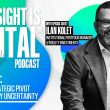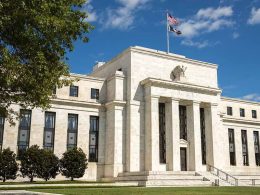by Nick Mersch, CFA, Associate Portfolio Manager, Purpose Investments
People thought Trump was playing 4D chess. Instead, he’s playing the world’s most dangerous game of chicken.
The market has plunged into a deep sell-off, with the MSCI World Index losing over $10T in equity value in three days.
Ten trillion.
In their current form, the tariffs that the U.S. is imposing on the global economy are a disaster. This is a structural shift that will cause slower growth, higher inflation, supply chain disruptions, weakened consumer demand, and increased business uncertainty.
Macroeconomic and geopolitical events will be the only things that matter in the medium term. While further escalation will cause global rolling recessions, any negotiations could swing the market in the other direction quickly.
Herein lies the opportunity.
Many stocks are seeing severe multiple compression despite being heavily invested in long-term secular trends that will endure for the coming decades. These stocks will be on sale in the coming months.
At the end of a rock concert, some people try to leave early to get out of the parking lot first. Others stay for the greatest moment of the entire show: the encore.
I’ll take the face-melting guitar solo over saving 10 minutes on the drive home.
The Tariff Man
The most important thing in the market right now is how transactive Trump will be in de-escalation. The threat and implementation of this level of tariffs are real, and they are very painful.
To put this into context, in Trump tariffs 1.0, the annual revenue generated by tariffs to the U.S. was approximately $70B. This time, the market was expecting tariffs to go in place that would result in around $200-300B in annual revenue for the U.S. What we got instead were tariffs that would equate to $700B in annual revenue. That is a massive delta that fundamentally re-architects global trade, reversing decades of globalization.
To understand just how adamant Trump is on tariffs, you have to get into his mind – which is a dangerous proposition. If you track his earlier writing and opinion pieces, you can see that Trump idolizes William McKinley. McKinley was the president of the United States at the turn of the 1900s, and referred to himself as “a tariff man, standing on a tariff platform.”
Trump has yet to capitulate on these tariffs (as of writing) and has provided commentary that there will be short-term pain for long-term gain. While this mantra is an effective strategy when weightlifting, it doesn’t quite work like that in the economy. He used to believe the stock market was his #1 measure of success, but this has been thrown out the window. Time will tell over the coming months, and he may pull something off, but the market has decided that these tariffs are real, they will be sticking around much longer than anticipated, and they will grind growth to a halt.
Impact on Tech
The largest impact on tech is the second-order effect of a slowdown in growth. Technology equities are mostly a leveraged bet on the growth of the overall economy. A heavy tariff regime introduces the incentive for businesses to cut budgets as a result of increasing costs. This includes advertising budgets, software budgets, and headcount cuts (which technology is sold into).
Technology companies with global supply chains are heavily impacted by these tariffs. This is the most direct first-order impact of tariffs. The best example of this is Apple. For years, Apple has been trying to diversify their supply chain away from China. However, it has done this by shifting manufacturing to India. While China got hit the hardest with tariffs, India was by no means immune, as their rate was 27% vs. China’s 54%.
This is a particular geopolitical disaster for the U.S. when it comes to the AI war. If you think about national interests, AI is at the center of all this. It can used in defense systems for significant military advantages, but most importantly, it increases productivity to put your economy ahead. What the U.S. just did was make itself the most expensive place in the world to build AI data centres.
Think about all the different networking components that you need: Memory, cooling, networking, etc. All of these come from countries like Taiwan, South Korea, Thailand, Malaysia, Vietnam, and Indonesia. The semiconductor exemption was irrelevant for AI. Data centre semiconductors come into America in finished goods from Taiwan and other Asian countries: servers, storage systems and networking switches.
Trump needs to cut deals with these friendly Asian countries quickly because these data centres are being built now.
In its current state, this level of tariffs is an epic win for China in the AI race.
Check-in on Secular Theme: AI
Now let’s shift gears away from tariff talk towards what we’re seeing on the ground floor. I want to caveat this first by saying macro and tariffs are firmly in the driver’s seat for the next couple of months. They are the only things that matter until they don’t… that’s when we can get back to focusing on companies that are changing the world. Have we had net new news that is thesis-breaking? Or are there exciting green shoots to look at?
The debate on overbuilt data centres heated on with several more data points on both sides of the ledger this month. On the overbuild side we had:
- Another TD Cowen report stated that Microsoft has walked away from 2GW of data centre LOIs. While this 2GW was entirely backfilled by Google and Meta and net demand YoY was still up, Microsoft’s pullback provided for some flashy negative headlines.
- Alibaba Chairman Joe Tsai warned of a potential bubble starting to form in US AI data center construction.
- CoreWeave’s IPO was a flop. They priced well below the lower end of the initial target range, and in line with a round done in the secondary market in November of last year. Additionally, they downsized the raise from $3B to $1.5B. However, after trading down in the day after launch, the stock ripped from $38 to above $60 before getting caught up in the global selloff. The market is still trying to make up its mind on this one.
- The DeepSeek scare is not yet over. An article from The Information highlighted how one cybersecurity firm is now spending 5% of what it used to on using DeepSeek vs. more established players.
On the positive demand side, we had:
- At GTC, Jensen Huang showed a very clear example of how reasoning models require 150x more compute than early models of AI. This iterative “thinking” process will demand more and more compute.
- OpenAI released a new imaging model that is a step function better than using a new technique that requires 10-15x more tokens than the previous model.
- Meta released Llama 4 with extremely impressive stats behind it. Llama models are 50x cheaper than GPT-4, open-sourced, and have a massive context window. Meta trained this model on a GPU cluster “bigger than anything seen reported for what others are doing”, which is encouraging.
- AI native startups are scaling revenue at the fastest rate in history, including:
- Bolt: $20M+ ARR in 2 months
- Cursor: $100M ARR in 21 months
- Midjourney: $200M ARR in 2 years
- Adoption is starting to increase. We’re seeing ChatGPT continue to grow its user base, which now sits at 400M weekly active users. More and more enterprises are finally starting to integrate into the workflow.
- Agent-to-agent proliferation will lead to billions (and then trillions) of interactions behind the scenes in real time.
While the overbuild debate still has very valid points on both sides of the tug of war, overall it’s hard to argue that the trend is not significantly higher. All roads lead to more compute. Humans tend to fail to recognize exponential growth curves because they look linear when you’re too close to them. We are still on the precipice of one of the greatest technological advancements of all time.
However, both sides of the overbuild argument could be true. We could be overbuilt in the short term and drastically underbuilt in the longer term. What happens in between will be fascinating to watch.
Final Thoughts
In times of extreme volatility, it is important to reassess your investment thesis. Macro headlines will continue to whipsaw markets. This will test both your resolve and conviction. The most important question to ask is, “What is the impact on longer-term trends?”
Structural changes require the ability to adapt and evolve. Rotation within portfolios is an effective measure to take advantage of dislocated opportunities, all while keeping the long-term secular thesis in mind.
We are by no means through the woods yet, but there are plenty of opportunities for those with a high tolerance for pain.
Strong convictions. Loosely held.
– Nick Mersch, CFA
Receive the latest tech insights in your inbox every month.
The content of this document is for informational purposes only and is not being provided in the context of an offering of any securities described herein, nor is it a recommendation or solicitation to buy, hold or sell any security. The information is not investment advice, nor is it tailored to the needs or circumstances of any investor. Information contained in this document is not, and under no circumstances is it to be construed as, an offering memorandum, prospectus, advertisement or public offering of securities. No securities commission or similar regulatory authority has reviewed this document, and any representation to the contrary is an offence. Information contained in this document is believed to be accurate and reliable; however, we cannot guarantee that it is complete or current at all times. The information provided is subject to change without notice.
Commissions, trailing commissions, management fees and expenses all may be associated with investment funds. Please read the prospectus before investing. If the securities are purchased or sold on a stock exchange, you may pay more or receive less than the current net asset value. Investment funds are not guaranteed, their values change frequently, and past performance may not be repeated. Certain statements in this document are forward-looking.
Forward-looking statements (“FLS”) are statements that are predictive in nature, depend on or refer to future events or conditions, or that include words such as “may,” “will,” “should,” “could,” “expect,” “anticipate,” intend,” “plan,” “believe,” “estimate” or other similar expressions. Statements that look forward in time or include anything other than historical information are subject to risks and uncertainties, and actual results, actions or events could differ materially from those set forth in the FLS. FLS are not guarantees of future performance and are, by their nature, based on numerous assumptions. Although the FLS contained in this document are based upon what Purpose Investments and the portfolio manager believe to be reasonable assumptions, Purpose Investments and the portfolio manager cannot assure that actual results will be consistent with these FLS. The reader is cautioned to consider the FLS carefully and not to place undue reliance on the FLS. Unless required by applicable law, it is not undertaken, and specifically disclaimed, that there is any intention or obligation to update or revise FLS, whether as a result of new information, future events or otherwise.
Copyright © Purpose Investments















